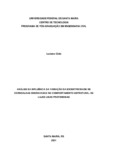| dc.creator | Cielo, Luciano | |
| dc.date.accessioned | 2021-09-13T17:39:58Z | |
| dc.date.available | 2021-09-13T17:39:58Z | |
| dc.date.issued | 2021-02-18 | |
| dc.identifier.uri | http://repositorio.ufsm.br/handle/1/22201 | |
| dc.description.abstract | The correct positioning of the tendons in the assembly and execution of prestressed
concrete slabs is essential for the structural system to present the real behavior in
place as designed, without changes in the stresses acting on the structure, avoiding
the appearance of pathological manifestations, such as unforeseen cracks, excessive
vertical displacements, reduced load capacity or even the collapse of the structure, in
more extreme cases. In this study, four distinct architectural models were dimensioned,
in the structural system of flat slabs in post-tensioned concrete, with unboned tendons,
and later variations in vertical eccentricities were inserted, and thus, to analyze the
new pre-compression stresses, stresses on the lower and upper faces, vertical
displacements, load balancing and passive reinforcement of the slabs. At the end of
the work, it can be seen that the reduction of vertical eccentricities on the lower face
of the slab, provided greater losses of stresses applied by prestressing, in relation to
the modification of the eccentricities of the upper face, showing decreases in load
balancing, increases in displacements vertical and normal tensile stresses on the slab
faces, mainly, exceeding the normative limits of ABNT NBR 6118:2014 for the
maximum allowable stresses in the position on the columns, on the upper face. Bearing
in mind that, the values of the analyzed criteria, remained in compliance with the
specified limits, the maximum increase in the values of overlayings, in relation to the
eccentricities of the tendons on the faces of the slabs, is 16,7 %. | eng |
| dc.language | por | por |
| dc.publisher | Universidade Federal de Santa Maria | por |
| dc.rights | Attribution-NonCommercial-NoDerivatives 4.0 International | * |
| dc.rights.uri | http://creativecommons.org/licenses/by-nc-nd/4.0/ | * |
| dc.subject | Concreto protendido | por |
| dc.subject | Protensão não aderente | por |
| dc.subject | Excentricidade de cordoalhas | por |
| dc.subject | Manifestações patológicas | por |
| dc.subject | Prestressed concrete | eng |
| dc.subject | Post-tensioned prestressed concrete | eng |
| dc.subject | Eccentricity of tendons | eng |
| dc.subject | Pathological manifestations | eng |
| dc.title | Análise da influência da variação da excentricidade de cordoalhas engraxadas no comportamento estrutural de lajes lisas protendidas | por |
| dc.title.alternative | Analysis of the influence of the variation of excentricity of unboned tendons on the structural behavior of posttensioned flat slabs | eng |
| dc.type | Dissertação | por |
| dc.description.resumo | O correto posicionamento das cordoalhas na montagem e execução de lajes em
concreto protendido é imprescindível para que o sistema estrutural apresente o
comportamento real in loco conforme o que foi projetado, sem alterações nas tensões
atuantes na estrutura, evitando o surgimento de manifestações patológicas, como
fissuras não previstas, deslocamentos verticais excessivos, redução na capacidade
de carga ou, até mesmo, o colapso da estrutura, em casos mais extremos. Neste
estudo, realizou-se o dimensionamento de quatro modelos arquitetônicos distintos, no
sistema estrutural de lajes lisas em concreto protendido não aderente, com cordoalhas
engraxadas, sendo posteriormente inseridas variações nas excentricidades verticais,
e assim, analisar as novas tensões de pré compressão, tensões nas faces inferior e
superior, deslocamentos verticais, balanceamentos de cargas e armaduras passivas
das lajes. Ao final do trabalho, pode-se verificar que a redução das excentricidades
verticais na face inferior da laje, proporcionaram maiores perdas de tensões aplicadas
pela protensão, em relação a modificação das excentricidades da face superior,
apresentando diminuições nos balanceamentos de cargas, aumentos nos
deslocamentos verticais e nas tensões normais de tração nas faces da laje,
principalmente, ultrapassando os limites normativos da ABNT NBR 6118:2014 para
as tensões máximas admissíveis na posição sobre os pilares, na face superior. Tendo
em vista que, os valores dos critérios analisados, mantiveram-se atendendo os limites
especificados, o máximo aumento dos valores de cobrimentos, em relação as
excentricidades das cordoalhas nas faces das lajes, é de 16,7%. | por |
| dc.contributor.advisor1 | Lima, Rogerio Cattelan Antocheves de | |
| dc.contributor.advisor1Lattes | http://lattes.cnpq.br/5518587537986438 | por |
| dc.contributor.advisor-co1 | Santos Neto, Almir Barros da Silva | |
| dc.contributor.advisor-co1Lattes | http://lattes.cnpq.br/5418069223727965 | por |
| dc.contributor.referee1 | Lübeck, André | |
| dc.contributor.referee1Lattes | http://lattes.cnpq.br/7511022637484145 | por |
| dc.contributor.referee2 | Milani, Alisson Simonetti | |
| dc.contributor.referee2Lattes | http://lattes.cnpq.br/6091255468174471 | por |
| dc.creator.Lattes | http://lattes.cnpq.br/1534154961990937 | por |
| dc.publisher.country | Brasil | por |
| dc.publisher.department | Engenharia Civil | por |
| dc.publisher.initials | UFSM | por |
| dc.publisher.program | Programa de Pós-Graduação em Engenharia Civil | por |
| dc.subject.cnpq | CNPQ::ENGENHARIAS::ENGENHARIA CIVIL | por |
| dc.publisher.unidade | Centro de Tecnologia | por |



